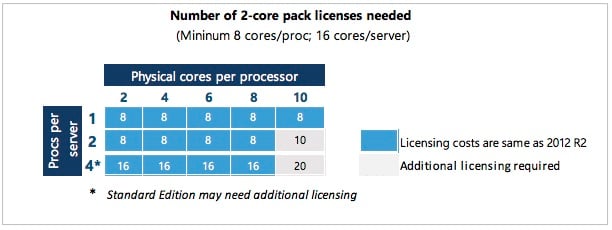
Posted on 12/03/2015 6:53:38 PM PST by dayglored
"We put in more, so you'll pay by the core"
Microsoft looks to be moving to per-core licences, rather than per-CPU licences, for Windows Server 2016.
"Directions on Microsoft" chap Wes Miller tweeted links to a "Pricing and licensing FAQ" for Windows Server 2016 and System Center 2016 Standard and Datacenter Editions. Dated December 2015, the meat of the document offers this description of Redmond's future licensing plan:
The licensing of Datacenter and Standard Edition will move from processors to physical cores, which aligns licensing of private and public cloud to a consistent currency of cores and simplifies licensing across multi-cloud environments. Licenses for servers with 8 cores or less per proc will be same price as the 2012 R2 two-proc license price.The document goes on to explain how you'll be able to buy licences, as follows:Core licenses will be sold in packs of 2 for incremental licenses needed above the required 8 cores per proc. The Standard Edition of Windows Server and System Center will license up to 2 VMs when all of the physical cores on the server are licensed.
Core licenses will be sold in packs of two licenses. Each processor will need to be licensed with a minimum of 8 cores, which is 4 two-core packs. Each physical server, including 1 processor server, will need to be licensed with a minimum of 16 cores, which is 8 two-core packs. Additional cores can then be licensed in increments of two cores (one two-core pack) for gradual increases in core density growth. Standard Edition provides rights for up to two virtual OSEs when all physical cores on a server are licensed (minimum of 8 cores per proc and 16 cores per server).Microsoft's documents say the company is doing this to make cores the common currency when licensing Windows Server. Redmond's already made moves in this direction on Azure, so per-core licensing for on-premises deployments means it should be easier to understand hybrid cloud costs.
There will be pain for users. As the graphic below shows, those of you with servers boasting two or four CPUs, and 10 or 20 cores, will require "additional licensing."

The company's justification for the changes is that Windows Server and System Center have lots of new features. So cough up, even if you don't plan on using them. Redmond can also point to the fact that it offers per-core licensing for other on-premises software, such as SQL Server and BizTalk, so it's actually doing you a favour by being more consistent.
Another nugget of information revealed in the FAQ is that Windows Nano Server is included as part of the licensing of the edition from which it is deployed.
You don't need to do anything about this for now. Microsoft says that "Customers will then begin transacting Windows Server and System by core-based licenses at the time of their software assurance renewal or at the time of net new license purchase outside of any Microsoft agreements."
In case Microsoft takes down the PDFs referred to in the Tweets, we've popped them into Dropbox here and here.
If you read the article, it’s plain to see that the cost doesn’t change from Server 2012 R2 Standard all the way up to 4x 8-core procs. This is much ado about nothing. We’re already in negotiations for our E3, and our pricing hasn’t changed at all.
It's not always that simple. Even with RHCSAs on staff, we still have to call Red Hat for support on issues that need to be resolved quickly. Given enough time, any engineer can solve any problem, but when you're talking about losses in the millions of dollars per hour range, time is literally money.
Same goes with Microsoft. While I have 20 years of experience with Microsoft operating environments and have Microsoft certifications, there are some issues I just need resolved quickly and have to rely on Microsoft for that reason.
Large corporations require extensive infrastructure to maintain business, and while supporting a single LAMP RHEL box is one thing, supporting a farm of 50 LAMP servers behind an F5 load balancer with WAN optimizers and other infrastructure considerations adds troubleshooting effort to any resolution timeline.
HA! You can, but you're on your own buddy!
One such meeting, my contact there, a program manager with a wicked sense of humor, was presenting, and at the end of the slides filled with the acronyms, he gave a summary of the possible outcomes with the customer, including a) continuing close relationship, b) loose cooperation, and c) something called "FYBYOYO", pronounced "fib-yo-yo".
Asked what it meant, he replied, "That's: 'F**k You Buddy, You're On Your Own".
It's come in handy many times in succeeding years.
FYBYOYO. I like it.
Including running it like crazy on Azure. Our Microsoft Account Engineer told us during our last briefing that Linux with OpenStack, Chef and Puppet along with MySQL were the fastest growing platforms in Azure.
They see the writing on the wall.
What's truly amazing is that I know a fair number of large organizations running Linux w/OpenStack and MySQL, Chef, Puppet and other Open Systems components and they all give Microsoft Azure very high marks for it. Enough so that some of them are shifting away from Amazon, RackSpace, etc.. Microsoft's making big in-roads in the Cloud.
I'm frankly very surprised by how fast they're doing it too.
First I've seen that one, and I love it! You can bet I'll be using that soon! :-)
Disclaimer: Opinions posted on Free Republic are those of the individual posters and do not necessarily represent the opinion of Free Republic or its management. All materials posted herein are protected by copyright law and the exemption for fair use of copyrighted works.